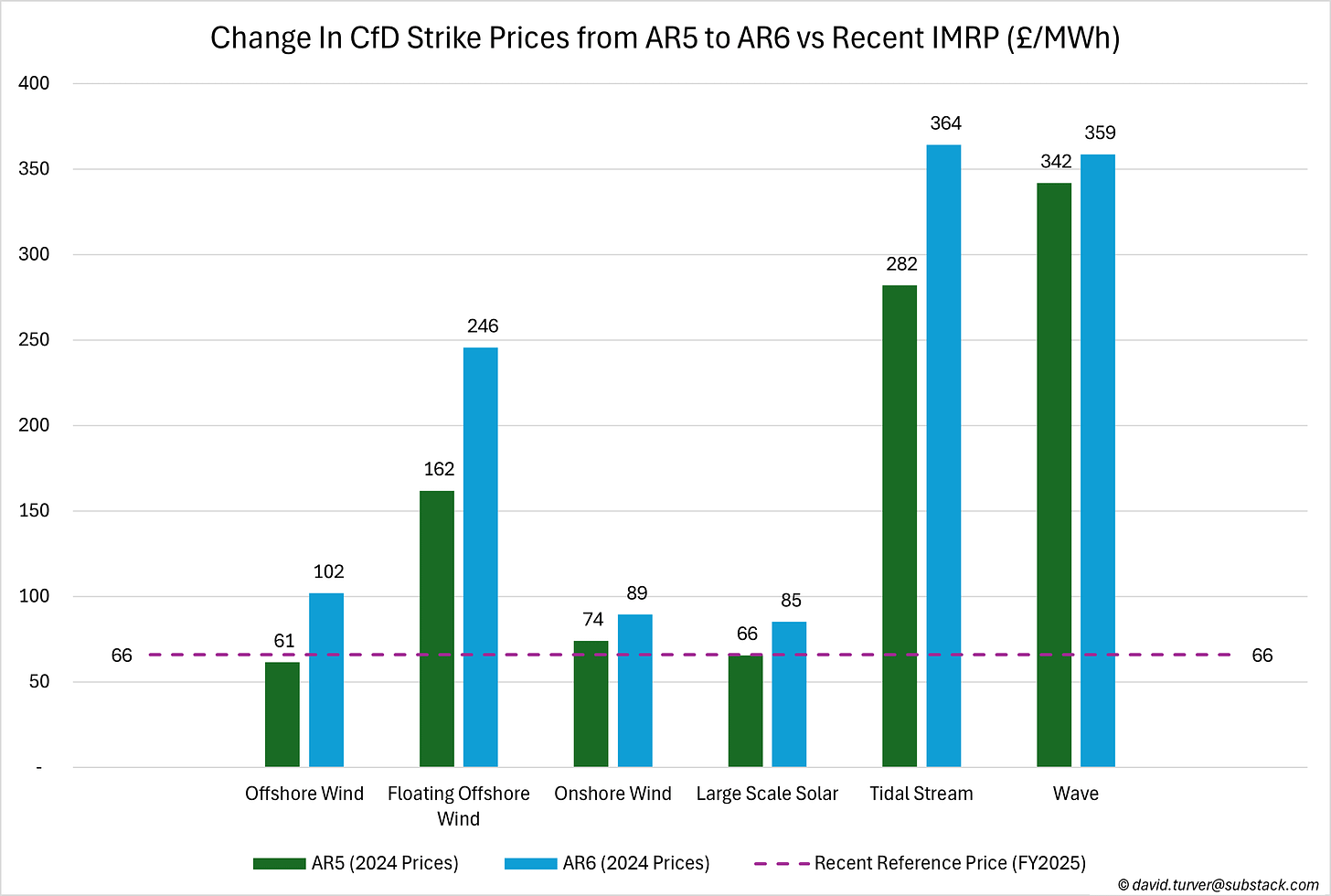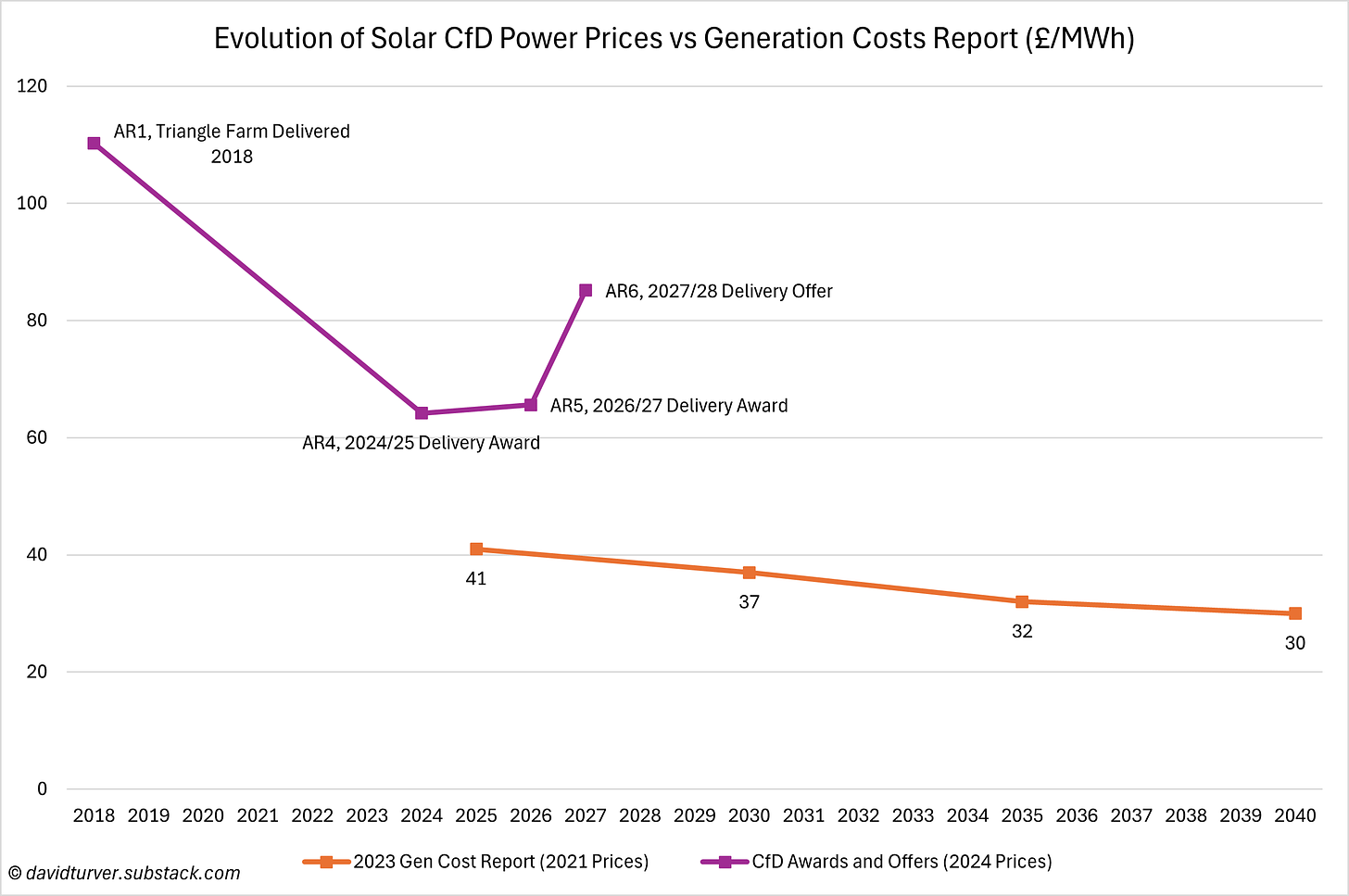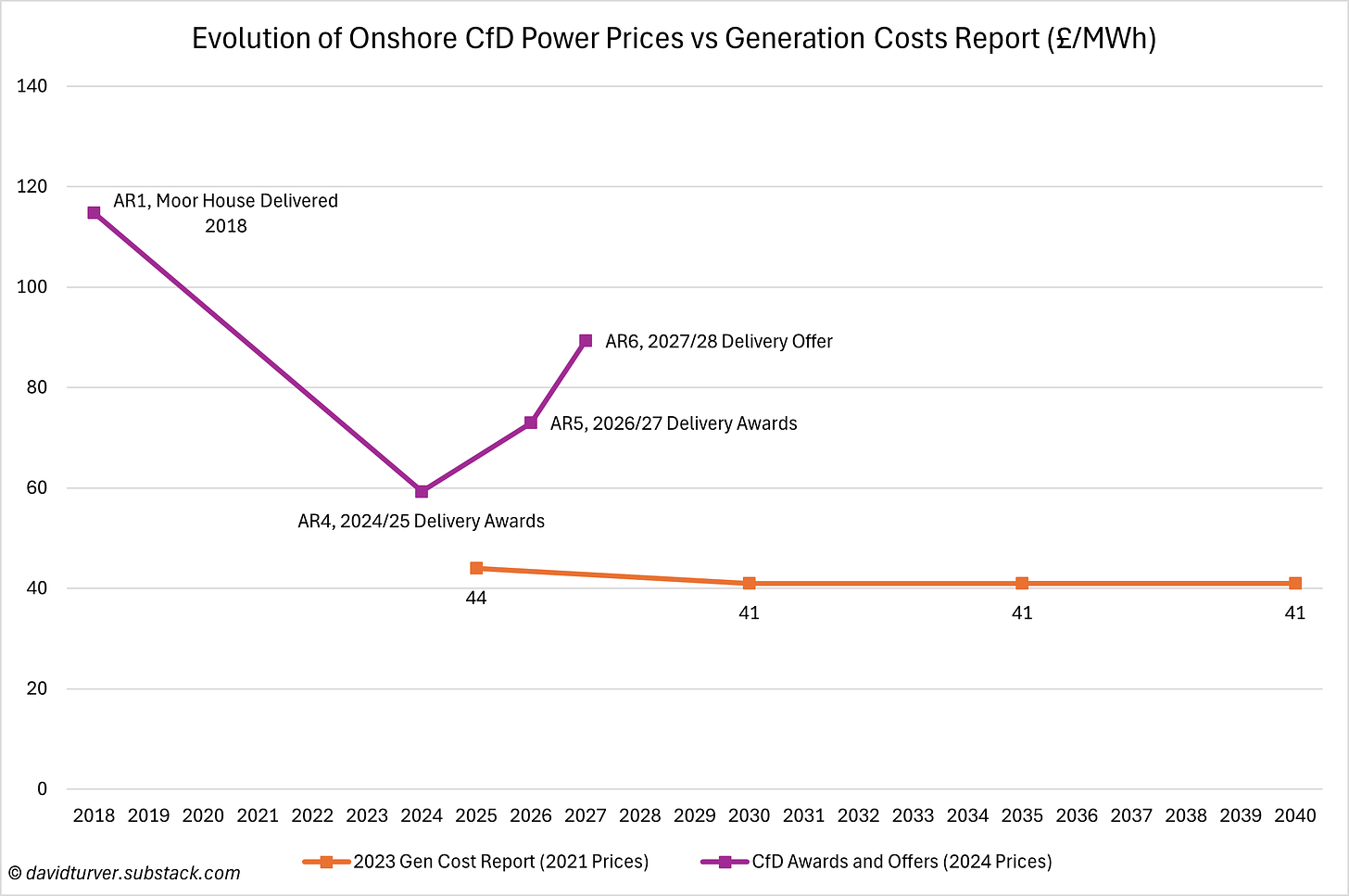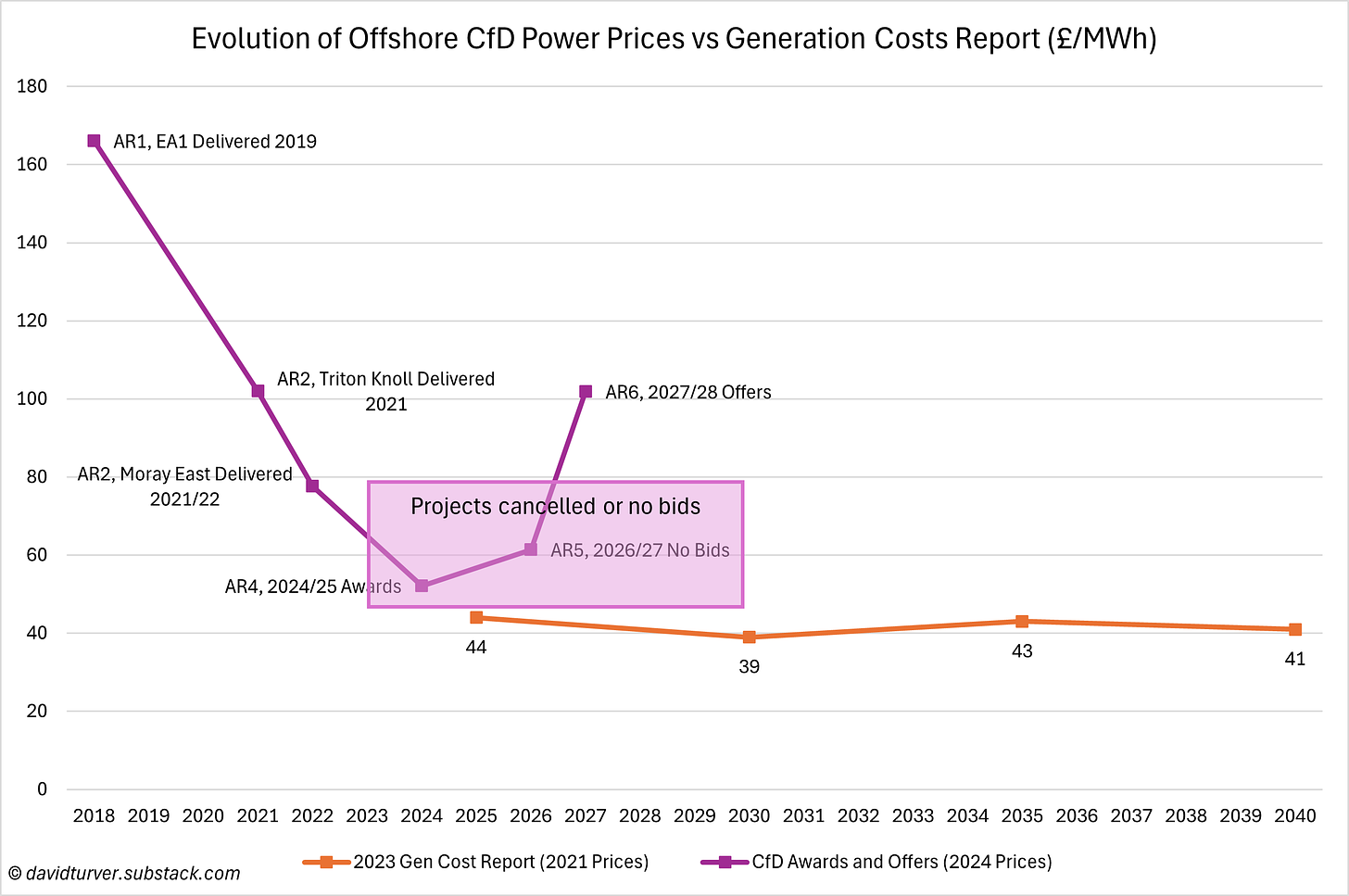The new Labour Government has set itself the mission of making Britain a “clean energy superpower” to “cut bills, create jobs and deliver security with cheaper zero-carbon electricity by 2030, accelerating to Net Zero”.
This article examines those claims and the forces that are likely to crush the Net Zero pipedream.
Cost of Renewables
First, as discussed here, existing intermittent renewables are much more expensive than the reliable gas-fired electricity which must be displaced if we are to achieve a zero carbon grid by 2030. Although new renewables are cheaper than the existing fleet, they are still much more expensive than gas-fired power as shown in Figure 1 below.
All the technologies that are being pushed by the Government for GB Energy and the debt-funded National Wealth Fund have increased in price since last year, and the basic costs of the Contracts for Difference (CfDs) are more expensive than the £66 per MWh average market price for the first four months of financial year 2024-25. The average market price is largely set by gas and includes carbon taxes.
In addition, we should add extra costs to renewables such as the £2.5 billion in grid balancing costs we paid last year and around £1 billion for the Capacity Market which would not be needed on such a scale if we did not have so much renewable capacity on the grid. Finally, National Grid ESO has announced £54 billion of spending on the electricity network infrastructure up to 2030 and a further £58 billion in the 2030-2035 period, a total of £112 billion. This is over £10 billion per year for more than a decade to connect remote intermittent renewables to the grid.
Yawning Gap Between Projections and Reality
The claim the Government is going to cut bills and deliver cheaper, cleaner zero-carbon electricity by 2030 looks to be on very shaky ground. We need to understand where this claim comes from. Many reports of cheaper renewables originate from the (previous) Government’s 2023 Generation Costs Report, which made some extraordinary claims that are proving to be untrue.
When two lines diverge on a chart, they are often referred to as ‘crocodile jaws’. As we shall see below, the crocodile jaws made by comparing the reality of contract awards and offers in the allocation round auctions to Government predictions are getting wider. The upper jaw in purple is the contract awards and offers and the lower jaw in orange is the Government projections made in the 2023 Generation Cost report. The yawning gap between projections and reality must surely crush its Net Zero plans.
Solar Power Projections vs CfD Awards and Offers
Let us start with solar power, see Figure 2. Remember Labour wants to triple solar capacity by 2030.
The Generation Cost report quoted all technologies using 2021 prices and they stated solar power could be delivered in 2025 at £41per MWh, falling to £30 per MWh by 2040. We can see that the price of solar power was over £110 per MWh (in 2024 prices) when Triangle Farm won a Contract for Difference (CfD) in AR1 and became operational in 2018. Prices then fell to AR4 with awards made for 2024-25 delivery in AR4 at £64 per MWh. That was the low point of offers and delivery, AR5 awarded contracts for 2026-27 delivery at £66 per MWh and AR6 is offering new contracts for 2027-28 delivery at £85 per MWh, more than double the Government projections for 2025 and 2030.
These recent offers are above current market prices, even without factoring in the extra costs that should be attributed to renewables, so there is no way that tripling solar power by 2030 will cut bills.
Onshore Wind Projections vs CfD Awards and Offers
Moving on to onshore wind, see Figure 3. Remember Labour wants to double onshore wind capacity by 2030.
The Generation Cost report stated onshore wind power could be delivered in 2025 at £44 per MWh, falling slightly to £41 per MWh by 2040. Moor House onshore wind farm was awarded a contract in AR1 and became operational in 2018 at a current price of over £110 per MWh. Prices then fell, with awards made for 2024-25 delivery in AR4 at £59 per MWh (at 2024 prices). That was the low point of offers and delivery, AR5 awarded contracts for 2026-27 delivery at £73 per MWh and AR6 is offering new contracts for 2027-28 delivery at £89 per MWh, more than double the Government projections for 2025 and 2030 and above recent gas-fired electricity prices. Again, there is no way that adding more expensive onshore wind capacity will bring down bills.
Offshore Wind Projections vs CfD Awards and Offers
Finally, we come to offshore wind, see Figure 4. Remember Labour wants to quadruple offshore wind capacity by 2030 and want it to become the largest source of renewable electricity.
The crocodile jaws of the chart are widest for offshore wind. The Generation Cost report stated offshore wind power could be delivered in 2025 at £44 per MWh, then fluctuating somewhat before settling at £41 per MWh by 2040. Prices have fallen since East Anglia 1 was awarded a contract in AR1 at £166 per MWh at today’s prices and activated its CfD in 2019. More recent projects such as Triton Knoll and Moray East also saw prices falling further. The low point of contract awards came with AR4 when projects for 2024-25 delivery at £52 per MWh (at 2024 prices) won the auction. However, we should remember that Vattenfall has pulled out of the Norfolk Boreas project that won a contract in AR4 because of soaring costs. Other projects are being offered the possibility of re-bidding parts of their projects at higher prices. AR5 offered contracts for 2026-27 delivery at £61 per MWh but received no bids. AR6 is offering new contracts for 2027-28 delivery at £102 per MWh, much more than double the Government projections for 2025 and 2030 and higher than gas-fired electricity. Again, adding more offshore wind capacity at these prices will only increase our energy bills.
Conclusions
It is clear the Department for Energy and Net Zero, under the previous Government, peddled dangerous disinformation in its Generation Costs report from 2023. The Department must know the prices it projected are wrong because it also sets the strike prices for the CfD auction rounds. But Labour and others use this report to substantiate their claim that renewables are getting cheaper.
In reality, the opposite is the case; renewables were never cheap and they are now getting much more expensive. More expensive than Government projections and more expensive than gas-fired electricity. Yet the Labour Government has recently increased the budget for AR6 so it can deliver even more of this more expensive, intermittent electricity. Labour has also announced that the Winter Fuel Allowance will be cut, reducing the ability of pensioners to pay for this more expensive electricity. Its self-declared mission to “cut bills, create jobs and deliver security with cheaper zero-carbon electricity by 2030” is in tatters. We can only hope that the jaws of the reality crocodile close soon to avoid further damage and the 2023 Generation Cost Report is withdrawn.
David Turver writes the Eigen Values Substack page, where this article first appeared.

















To join in with the discussion please make a donation to The Daily Sceptic.
Profanity and abuse will be removed and may lead to a permanent ban.
Well done for keeping pushing, their lies need to be exposed if we are to save what is left of the country our parents bequeathed us.
It really is that serious.
There lies have been evident since the start of the century.
It’s much worse than this because “renewables” are intermittent and there’s close to zero reliable storage so they require non-intermittent backups which need to be built and maintained and at least kept ticking over. Double bubble!
There are no non-intermittent back-ups. Storage is just that, it does not generate electricity.
Discharge cannot be continuous once the storage has drained, and recharge is dependent on intermittent recharge.
By non-intermittent backups I meant gas, nuclear etc.
Regarding storage you’d need enough to cover demand for whatever the maximum period could be that your intermittent sources might be offline – good luck calculating that! Anyway, such storage simply doesn’t exist and cannot be built with existing technology.
“It is clear the Department for Energy and Net Zero, under the previous Government,”
It’s the same Department/people with the same agenda. It doesn’t matter what government it is.
One difference is that the Tories knocked it back to 2035 for most of it. Not much of a difference but it was some. But the Eco Fundamentalists at Labour, led from the front by Miliband want it back inline with the UN Agenda 2030.
There will be a tipping point, not too far away, when this whole house of cards comes crashing down. The MSM will suddenly ‘wake up’ (I.e. they can’t deny what’s happening around them) and start asking why the Government has been misleading them.
It will probably need a really cold winter, or some incident that prevents power being imported. This Government is on collision course with reality.
Correct – and most of them are not in Whitehall.
What a wonderful photo of the “Reality Crocodile”!
Of course Labour’s plans can’t be delivered by the next election because the resources to do so do not exist. It will be amusing to watch as this reality begins to hit.
In 2027/8 when it’s become obvious that our electricity won’t be carbon free by 2030 they’ll no doubt blame the Conservatives for saddling us with too much debt and not investing enough in renewable energy. Similarly our sky high energy prices will be blamed on world markets and (possible) periodic black/brown outs on squirrels shagging on the transmission lines or anything else apart from. their madcap schemes.
From now on I shall refer to power cuts as “squirrel shagging incidents”.
funny
Yes, but as the Dark Lord has explained, that’s why we need to entrust him with a second term, from amidst the wreckage of his first.
It is all the rage at the moment for governments to attack “Fake News” and “Misinformation”. —–As it happens, and very bad news for ordinary people is that most “Fake News” and “Misinformation” we get all comes from Government. Everything we hear from them and the consolidated media is either a smidgeon of the truth or a bare faced lie, especially on the issue of energy and climate.
——I have been investigating the climate/energy situation since about 2007 so I don’t need to look at any graphs to know that Miliband and Labour are LIARS. Energy bills are going in one direction only ————UP.
—–But the other aspect to this is that they want the price to go up to discourage use. It isn’t the case that they have just made a mistake and really believe the prices will come down. They know full well that prices will rise astronomically. The National Grid estimates the cost of Net Zero to be 3 trillion and it is the people who pay for all of that via their bills. ———-But then we have to ask ourselves “Why are we forcing ourselves in law to do all of this by 2030”.? What is the big hurry? The rest of the world isn’t doing this so why should we? This pathetic group think answer that we want to be “world leaders” is utterly feeble. They want to do it by 2030, because that is what the UN Agenda 2030 wants. So our politicians are prepared to impoverish us all so they can suck up the arses of the UN.
Using “Bid prices” is the government’s way of adding confusion to the real data. Can we please have the following real cost:
That way the real cost of this monstrous con-job will become clear.
The strike price had to be increased because wind and solar companies weren’t bidding.
No more of Millibrain’s wind turbines will get built unless higher prices are guaranteed for the future, otherwise wind and solar companies cannot make a return on their investment and pay dividends to shareholders.
Adding increased uncertainty into any system does not reduce it. Adding more intermittency only increases the scale when – supposedly – more electrical supply is reliant on unreliable, unpredictable, inconsistent generation.
Physics + Economics = Bankruptcy.
Evidently the intent is to bankrupt the People.
Can someone point out where this £66 reference price comes from, I can’t find anything on it?